- Choosing the Right Location
- Preparing the Soil
- Planting Muscari Bulbs
- Watering and Fertilizing
- Watering
- Fertilizing
- Pruning and Deadheading
- Pruning
- Deadheading
- Pest and Disease Control
- 1. Aphids
- 2. Slugs and Snails
- 3. Fungal Diseases
- 4. Rodents and Deer
- Dividing and Transplanting
- Enjoying and Maintaining the Blooms
- Watering
- Pruning
- Deadheading
- Fertilizing
- Dividing and Transplanting
- Protecting from Pests
- Questions and Answers:
- How do I care for muscari plants in my garden?
- Can I grow muscari indoors?
- How deep should I plant muscari bulbs?
- When is the best time to plant muscari bulbs?
- Can muscari plants tolerate cold climates?
- Videos: Planting #muscari #bulb in Winter 2023
Muscari, also known as grape hyacinth, is a beautiful flowering plant that can add a touch of color and fragrance to your garden. With its clusters of small, bell-shaped flowers, muscari is a popular choice for many gardeners. Whether you’re a beginner or an experienced gardener, these tips will help you grow and care for muscari in your garden.
When it comes to planting muscari, choose a location that receives full sun or partial shade. Muscari prefers well-drained soil, so make sure to prepare the soil by adding organic matter or compost. Before planting, soak the bulbs in water for a few hours to help them establish roots.
One important aspect of muscari care is watering. While muscari is drought-tolerant and doesn’t require frequent watering, it’s important to water the plants deeply when you do water them. This will encourage deep root growth and help the plants withstand dry periods.
To ensure the health and longevity of your muscari plants, it’s essential to fertilize them regularly. Use a balanced, slow-release fertilizer in the spring and mid-summer. Avoid over-fertilizing, as this can lead to excessive foliage growth and fewer flowers.
Lastly, don’t forget to deadhead your muscari plants. This involves removing the faded flowers to encourage new growth and extend the flowering period. Once the flowers have finished blooming, allow the foliage to die down naturally before cutting it back. This will allow the plant to store energy for the next growing season.
By following these tips for growing and caring for muscari, you can enjoy the beauty of this delightful plant in your garden year after year. Whether you plant them in borders, rock gardens, or containers, muscari is sure to bring a burst of color and charm to your outdoor space.
Choosing the Right Location
When it comes to growing and caring for muscari plants in your garden, choosing the right location is key to their success. Muscari plants, also known as grape hyacinths, thrive in full sun to partial shade conditions.
Here are some factors to consider when selecting the ideal location for your muscari:
- Sunlight: Muscari plants require at least six hours of direct sunlight each day. Choose a location in your garden that receives adequate sunlight, especially during the spring when these plants are in bloom.
- Soil drainage: Muscari plants prefer well-drained soil. They do not tolerate soggy or waterlogged conditions. Ensure that the location you choose has good drainage, or amend the soil with organic matter to improve drainage.
- Soil pH: Muscari plants grow best in neutral to slightly alkaline soil with a pH level between 6.0 and 7.5. Test your soil’s pH and amend it accordingly to provide the ideal growing conditions for your muscari.
- Protection from strong winds: Muscari plants have delicate blooms that can be damaged by strong winds. Choose a location that provides some protection from strong winds, such as planting them near a fence, wall, or taller plants.
By considering these factors and selecting the right location for your muscari plants, you can ensure optimal growth and bloom. Remember to water your muscari regularly, especially during dry periods, and provide them with occasional fertilizer to promote healthy growth and vibrant blooms.
Preparing the Soil
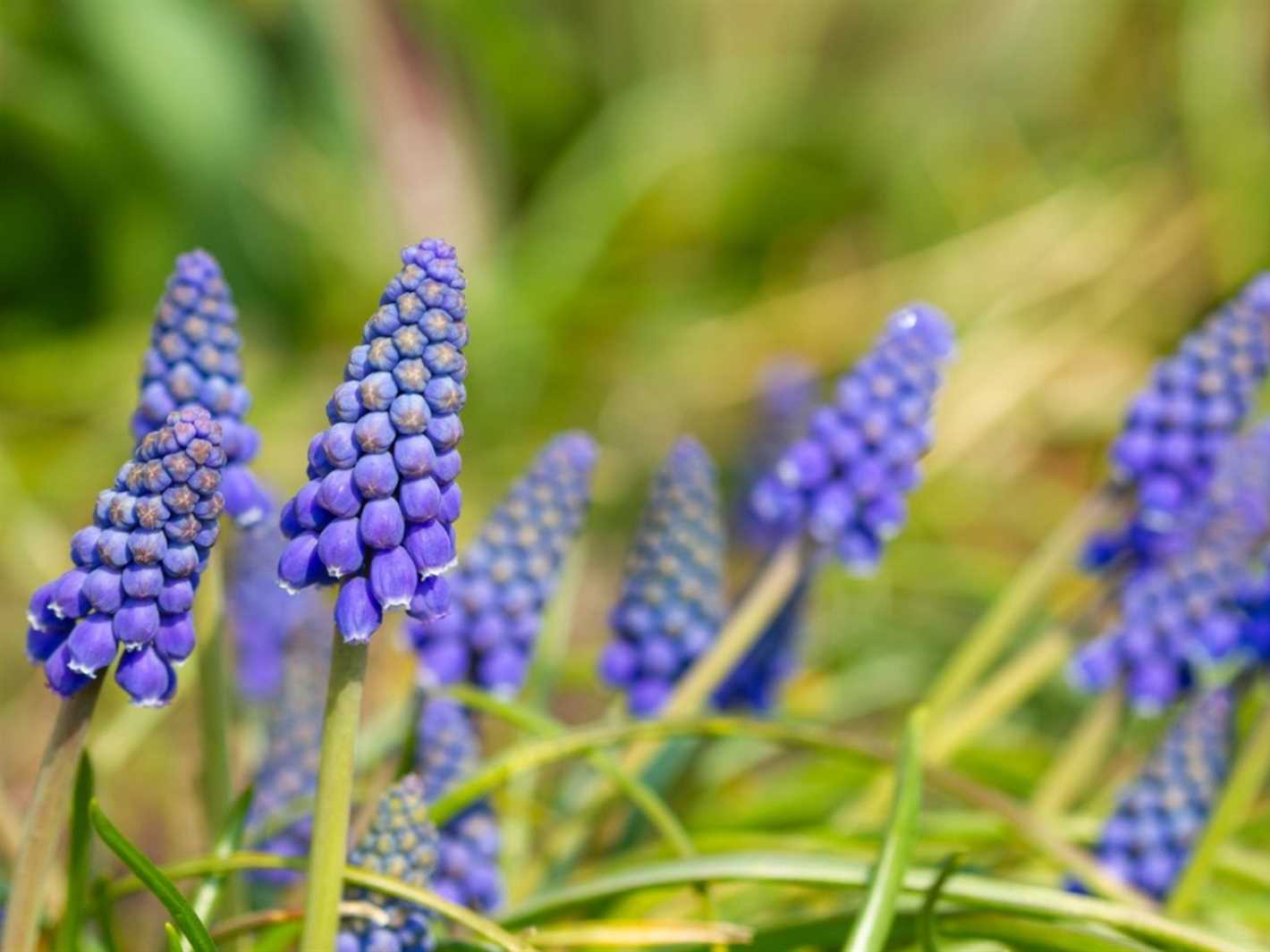
Proper soil preparation is essential for growing healthy and thriving Muscari plants. Here are some tips to help you prepare the soil for planting:
- Choose the right location: Muscari plants prefer well-draining soil and full sun to partial shade. Select a location in your garden that receives at least 6 hours of sunlight a day.
- Clear the area: Remove any weeds or grass from the planting area to reduce competition for nutrients and water.
- Loosen the soil: Use a garden fork or tiller to loosen the soil to a depth of at least 8 inches. This will help promote root growth and improve drainage.
- Add organic matter: Incorporate compost or well-rotted manure into the soil to improve its fertility and overall structure. This will provide essential nutrients for the Muscari plants.
- Test the pH: Muscari plants prefer a slightly acidic to neutral soil pH range of 6.0 to 7.0. Test the pH of your soil using a soil testing kit and make any necessary adjustments using organic amendments.
- Amend heavy clay soil: If you have heavy clay soil, add sand or perlite to improve drainage and prevent waterlogging.
- Level the soil: Rake the soil surface to create a smooth and level planting area for the Muscari bulbs.
By following these soil preparation tips, you will provide a favorable environment for Muscari plants to establish and thrive in your garden. Remember to water the plants regularly and provide adequate mulch to help retain moisture in the soil.
Planting Muscari Bulbs
Planting muscari bulbs is a simple and rewarding process that can add beautiful pops of color to your garden. Here are some tips to help you successfully plant muscari bulbs:
- Choose the right location: Muscari bulbs prefer full sun to light shade. Pick a location in your garden that receives at least 6 hours of sunlight each day.
- Prepare the soil: Muscari bulbs prefer well-draining soil. Before planting, loosen the soil with a garden fork or tiller and remove any weeds or debris.
- Plant at the right depth: Dig a hole that is two to three times the height of the bulb. Place the muscari bulb in the hole with the pointed end facing up. Cover the bulb with soil, firming it gently around the bulb.
- Spacing: Space muscari bulbs about 2-3 inches apart to allow them enough room to grow and spread.
- Watering: After planting, water the bulbs thoroughly. Keep the soil consistently moist during the bulb’s growing season, but be careful not to overwater, as excessive moisture can cause the bulbs to rot.
- Maintenance: Once the muscari bulbs are planted, there isn’t much maintenance required. However, you may want to mulch around the bulbs to help retain moisture and suppress weeds.
Muscari bulbs are typically planted in the fall, before the ground freezes. They will go dormant during the winter months and bloom in the spring, adding a burst of color to your garden.
By following these simple steps, you can enjoy the beauty of muscari bulbs in your garden year after year.
Watering and Fertilizing
Proper watering and fertilizing are essential for the healthy growth of muscari plants. Here are some tips to help you water and fertilize your muscari effectively:
Watering
- Water your muscari plants regularly, especially during the growing season.
- Provide enough water to keep the soil consistently moist, but not waterlogged.
- Check the soil moisture level by sticking your finger about an inch into the soil. If it feels dry at this depth, it’s time to water.
- Water the plants at the base, rather than overhead, to avoid wetting the leaves, which can lead to fungal diseases.
- Avoid overwatering, as it can cause root rot and other problems. Allow the topsoil to dry out slightly between watering.
Fertilizing
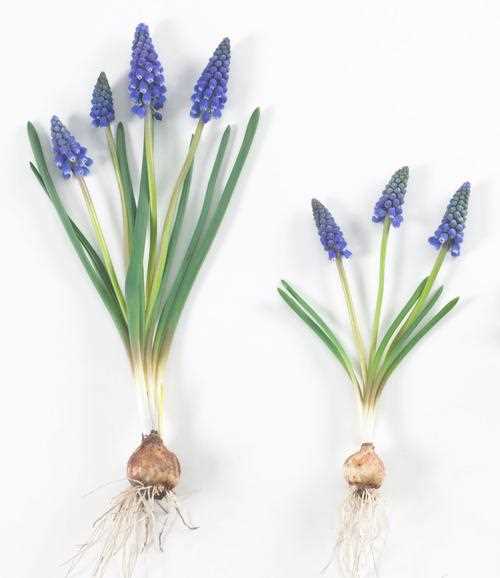
- Apply a balanced, slow-release fertilizer during the growing season to provide essential nutrients to the muscari plants.
- Choose a fertilizer with a ratio of nitrogen (N), phosphorus (P), and potassium (K) of 10-10-10 or 14-14-14.
- Follow the manufacturer’s instructions for the recommended amount of fertilizer to use.
- Apply the fertilizer evenly around the plants, keeping it away from direct contact with the leaves and stems.
- Water the plants after fertilizing to help the nutrients penetrate the soil and reach the root zone.
- Repeat the fertilizer application every four to six weeks throughout the growing season.
By providing adequate water and nutrients, you can ensure the healthy growth and blooming of your muscari plants. Remember to monitor the soil moisture and adjust your watering and fertilizing practices accordingly. With proper care, your muscari will reward you with beautiful flowers year after year.
Pruning and Deadheading
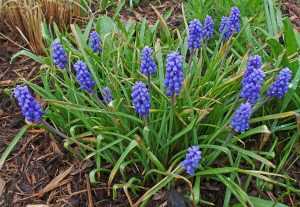
Pruning and deadheading are important tasks in caring for muscari plants. Proper pruning helps maintain the health and appearance of the plants, while deadheading encourages more blooms and prolongs the flowering period.
Pruning
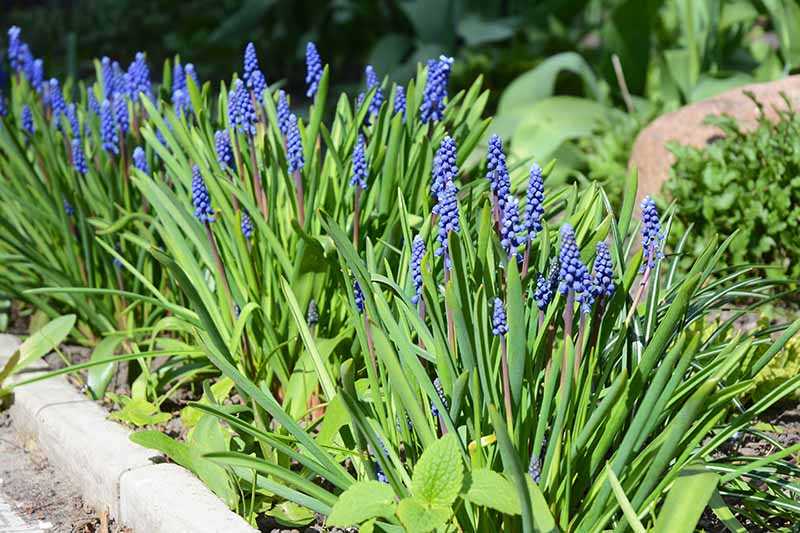
Pruning muscari plants should be done after the flowering period is over, typically in late spring or early summer. Use clean and sharp pruning shears to remove any damaged, diseased, or dead foliage. Cut the leaves back to the base of the plant, taking care not to damage the healthy leaves or emerging flower buds.
In addition to removing the damaged foliage, you can also prune muscari plants to improve their shape and promote compact growth. Trim back any long or leggy stems to encourage a more bushy and rounded appearance. However, be careful not to remove too much of the plant’s foliage, as it is necessary for photosynthesis and energy production.
Deadheading

Deadheading is the process of removing spent flowers from the muscari plants. This practice not only improves the overall appearance of the plant but also encourages more blooms. Deadheading redirects the plant’s energy from seed production to the development of new flower buds.
To deadhead muscari plants, simply pinch or snip off the faded flowers at the base of the stem. Alternatively, you can use pruning shears to cut off the entire flower stalk if it has finished blooming. Be sure to clean your pruning tools with rubbing alcohol before and after each use to prevent the spread of diseases.
It is important to note that while deadheading can promote more blooms, it is not necessary for the health and survival of muscari plants. If you prefer a more natural look in your garden, you can simply allow the plant to drop its seeds and let them self-sow.
Pest and Disease Control
Muscari plants are generally resistant to pests and diseases, but they can still be susceptible to a few common problems. Here are some tips on how to control pests and diseases that may affect your Muscari plants:
1. Aphids
Aphids are small insects that suck sap from the leaves and stems of plants. To control aphids on your Muscari plants, you can try the following methods:
- Spray a strong jet of water on the affected plants to dislodge the aphids.
- Introduce natural predators, such as ladybugs or lacewings, that feed on aphids.
- Apply a natural insecticidal soap or neem oil spray to the plants.
2. Slugs and Snails
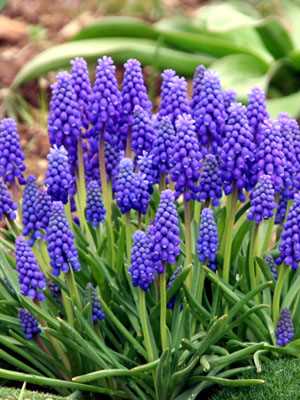
Slugs and snails can be a common problem in gardens and can damage Muscari plants by eating their foliage. Here are some ways to control slugs and snails:
- Remove any debris or objects in your garden where slugs and snails can hide.
- Set up traps, such as beer traps or copper barriers, to catch and deter slugs and snails.
- Use organic slug and snail baits or granules, following the instructions on the product.
3. Fungal Diseases
Muscari plants can occasionally be affected by fungal diseases, such as gray mold or powdery mildew. To prevent and control fungal diseases:
- Ensure good air circulation around your Muscari plants by spacing them adequately.
- Avoid overhead watering, as it can promote the development of fungal diseases.
- If necessary, apply a fungicide approved for use on ornamental plants, following the instructions on the product.
4. Rodents and Deer
Rodents, such as mice or voles, and deer can sometimes feed on Muscari plants. To protect your plants, you can try the following measures:
- Install fencing around your garden to keep out deer and other large animals.
- Set up traps or use natural repellents to control rodents.
- Consider planting Muscari bulbs in containers or raised beds to make them less accessible to wildlife.
By following these pest and disease control measures, you can help ensure the health and beauty of your Muscari plants in your garden.
Dividing and Transplanting
If your muscari bulbs have become overcrowded or you simply want to propagate them, dividing and transplanting is a simple and effective way to rejuvenate your plants and create new ones.
Here are some steps to follow when dividing and transplanting muscari bulbs:
- Choose the right time: The best time to divide and transplant muscari bulbs is in the fall, after the foliage has died back. This allows the bulbs to establish new roots before winter.
- Dig up the bulbs: Use a garden fork or shovel to carefully lift the clump of muscari bulbs from the ground. Be careful not to damage the bulbs or their roots.
- Separate the bulbs: Gently separate the individual bulbs from the clump. Some bulbs may naturally separate, while others may need to be carefully pulled apart.
- Inspect the bulbs: Check each bulb for signs of disease or damage. Discard any bulbs that appear unhealthy.
- Prepare the new planting site: Choose a location with well-draining soil and partial shade. Dig a hole that is slightly deeper than the length of the bulb.
- Plant the bulbs: Place the bulbs in the hole with the pointed end facing up. Space the bulbs about 2-3 inches apart to allow for future growth.
- Backfill the hole: Fill the hole with soil, making sure to cover the bulbs completely. Gently press the soil down to eliminate any air pockets.
- Water the newly transplanted bulbs: Give the newly transplanted bulbs a good watering to settle the soil and provide moisture.
- Maintain and care for the transplanted bulbs: Continue to water the transplanted bulbs regularly, especially during dry periods. Apply a layer of mulch to help retain moisture and suppress weeds.
- Monitor growth and flowering: Keep an eye on the transplanted bulbs to ensure they are growing and flowering properly. If any issues arise, address them promptly.
By following these steps, you can successfully divide and transplant your muscari bulbs, allowing you to expand your garden and enjoy the beauty of these charming spring flowers.
Enjoying and Maintaining the Blooms
To fully enjoy the beautiful blooms of Muscari in your garden, there are a few maintenance tips to keep in mind.
Watering
Muscari generally require moderate watering. However, it’s important to avoid over-watering, as this can lead to root rot. Water the plants deeply once a week, allowing the soil to dry out slightly between waterings.
Pruning
After the flowers have finished blooming, it’s a good idea to prune the foliage. Simply cut back the leaves to the base of the plant. This helps divert energy back to the bulb and promotes healthier growth for the next season.
Deadheading
Deadheading refers to the removal of faded flowers. By removing these spent blooms, you not only maintain a tidy appearance but also encourage the plant to put energy into producing new flowers rather than setting seeds.
Fertilizing
Muscari typically do not require heavy fertilization. However, you can apply a slow-release, balanced fertilizer in early spring to provide some nutrients for overall plant health.
Dividing and Transplanting
Over time, Muscari clumps can become congested, resulting in fewer blooms. To prevent this, consider dividing the clumps every 3-4 years in early fall. Gently lift the clumps and separate the bulbs, then replant them at the appropriate depth.
Protecting from Pests
Muscari are generally resistant to pests and diseases. However, they can occasionally attract aphids, slugs, or snails. Monitor your plants regularly and take appropriate measures to control these pests if necessary.
By following these tips and providing proper care, you can ensure a healthy and vibrant display of Muscari blooms in your garden for years to come.
Questions and Answers:
How do I care for muscari plants in my garden?
To care for muscari plants in your garden, you should plant them in well-draining soil, water them regularly, and provide them with enough sunlight. It is also important to deadhead the flowers after they bloom and fertilize the plants once a year.
Can I grow muscari indoors?
Yes, you can grow muscari indoors. They can be grown in pots or containers, as long as you provide them with enough sunlight and water. You can also bring them indoors after they bloom outdoors to enjoy their beautiful flowers.
How deep should I plant muscari bulbs?
Muscari bulbs should be planted about 2 to 3 inches deep in the soil. Make sure to space them about 2 to 3 inches apart as well. This will allow the bulbs to have enough room to grow and produce flowers.
When is the best time to plant muscari bulbs?
The best time to plant muscari bulbs is in the fall, preferably before the first frost. This will allow the bulbs to establish their roots before the cold winter months. Planting them in the fall will also ensure that they bloom in the spring.
Can muscari plants tolerate cold climates?
Yes, muscari plants are hardy and can tolerate cold climates. They are known for their ability to withstand freezing temperatures. However, it is important to provide them with a layer of mulch during winter to protect the bulbs and ensure their survival.







